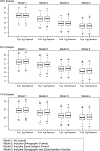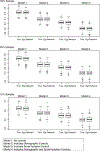Estimating Contextual Effects from Ego Network Data
- PMID: 32831423
- PMCID: PMC7434046
- DOI: 10.1177/0081175020922879
Estimating Contextual Effects from Ego Network Data
Abstract
Network concepts are often used to characterize the features of a social context. For example, past work has asked if individuals in more socially cohesive neighborhoods have better mental health outcomes. Despite the ubiquity of use, it is relatively rare for contextual studies to employ the methods of network analysis. This is the case, in part, because network data are difficult to collect, requiring information on all ties between all actors. This paper asks whether it is possible to avoid such heavy data collection while still retaining the best features of a contextual-network study. The basic idea is to apply network sampling to the problem of contextual models, where one uses sampled ego network data to infer the network features of each context, and then uses the inferred network features as second-level predictors in a hierarchical linear model. We test the validity of this idea in the case of network cohesion. Using two complete datasets as a test, we find that ego network data are sufficient to capture the relationship between cohesion and important outcomes, like attachment and deviance. The hope, going forward, is that researchers will find it easier to incorporate holistic network measures into traditional regression models.
Keywords: Adolescents; Cohesion; Ego Networks; Exponential Random Graph Models; Hierarchical Linear Models; Network Sampling.
Figures







References
-
- Alwin Duane F. 2007. Margins of Error: A Study of Reliability in Survey Measurement, Vol. 547: John Wiley & Sons.
-
- Anderson Brigham S., Butts Carter and Carley Kathleen. 1999. “The Interaction of Size and Density with Graph-Level Indices.” Social Networks 21(3):239–67. 10.1016/S0378-8733(99)00011-8. - DOI
-
- Bearman Peter S. 1991. “The Social Structure of Suicide.” Sociological Forum 6(3):501–24. 10.1007/bf01114474. - DOI
Grants and funding
LinkOut - more resources
Full Text Sources
Miscellaneous
